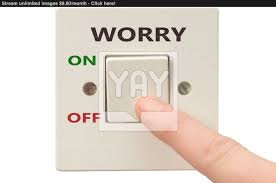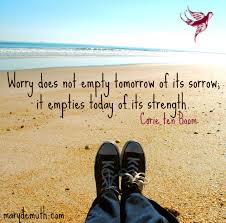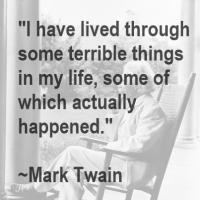Dealing with worry
That the birds of worry and care fly above your head, this you cannot change, but that they build nests in your hair, this you can prevent.” (Chinese proverb)
Everyone worries from time to time. But for some people, worry is a way of life. I know that it’s been a significant factor for me over the years (though thankfully lessening with age and cumulative learning), often getting wound up before a big group facilitation session or a possible altercation with someone, situations which in pretty much all cases never turn out to be as bad as I thought they would be. On the positive side, you may believe that your worrying helps you avoid bad things, prevents problems, prepares you for the worst, or leads to solutions; sometimes we forget that worry often does have a justification, although maybe not the size of worry we build it up to be!
 On the negative side though, you can believe that your constant worrying is harmful and could affect your physical health. Or you may worry that you’re going to lose all control over your worrying—that it will take over and never stop.
On the negative side though, you can believe that your constant worrying is harmful and could affect your physical health. Or you may worry that you’re going to lose all control over your worrying—that it will take over and never stop.
So I took a look on the internet to see what was out there, intrigued by some of the more “CBT” approaches to thinking your way out of it and working on not catastrophising, set against some of the latest approaches though approaches like acceptance and commitment therapy, which work more on the basis of accepting that worry happens and letting go of trying to control them. Amidst a vast array of “worry cures” that are out there, I came up with two approaches which I thought have some inherent worth as coping strategies.
Acceptance and commitment approach
Chad LeJeune in his book The worry trap; how to free yourself from worry and anxiety using acceptance and commitment therapy focuses on “letting go of the struggle to control unwanted thoughts and feelings, being mindfully aware of the present moment, and committing to a course of action that is consistent with what you value most in life.”
 Before delving into the model, LeJeune says that it’s important to learn how worry works. Imagine you’re hiking along a cliff, he says. Your brain tells you “I might fall,” and you picture yourself falling. This thought helps you realize that you need to be extra careful about where you’re walking. This is “a helpful thought to have,” he says.
Before delving into the model, LeJeune says that it’s important to learn how worry works. Imagine you’re hiking along a cliff, he says. Your brain tells you “I might fall,” and you picture yourself falling. This thought helps you realize that you need to be extra careful about where you’re walking. This is “a helpful thought to have,” he says.
However, “when your anxiety is high, you’ll experience that image not as ‘I might fall,’ [but as] ‘I will fall.’” With heightened anxiety, “we’re less able to discriminate [between] the thought that might happen” and the reality. This is called “cognitive fusion,” when “a thought becomes fused with what it refers to.” We experience a thought “as a reality, an almost inevitability.”
Evolutionarily speaking, cognitive fusion is adaptive, LeJeune says. Consider this scenario: A person is sitting in a forest and hears something rustling through the bushes. “It could be something dangerous, like a tiger, or something benign, like a small animal,” LeJeune says. “The brain starts to generate hypotheses about what it could be.” The person who didn’t pay much attention to the thought “It might be a tiger” “got eaten first.” But the other person, whose anxiety shot up, responded by running away. He didn’t wait around to see who the noise belonged to. He assumed the situation was dangerous and got out of there. So “it’s more adaptive in a dangerous situation to experience your thoughts as real.” But this can backfire when the situation isn’t risky, fuelling anxiety and worry.
The 5-Step Model
- Label worry thoughts.
This step is about identifying “when the phenomenon of worry is happening.” Most worriers have worries around several similar themes, such as health, their job, relationships and finances. Because people see their worries as facts, it can be hard to distinguish a normal thought from a worry thought.
In the book, LeJeune writes that worry thoughts typically follow patterns such as “what if” thoughts (e.g., “What if I’m terminally sick?” “What if I faint?”) and ruminations. When people ruminate, they typically think and worry about the past, sometimes strongly wishing that they could go back in time and make a different decision. People also can ruminate around the word “Why.” For instance, you might ask yourself “Why is that today there’s a torrent of traffic?” or “Why does this have to happen to me of all people?”
Labelling your worry thoughts lets you know when to apply the model, and helps you start separating yourself from these thoughts.
- Let go of control.
This step encourages worriers to slow down the fight-or-flight response and relax the body by using “traditional stress management” techniques. Examples include breathing deeply and relaxing your hands and all your muscles.
But this isn’t to gain control over your anxiety. Trying to overpower worry only ignites anxiety and worry thoughts. When you “have a thought you don’t like, your body responds by struggling physically to control it and escape from it. And that intensifies the thought.”
So your goal is actually the opposite — to interrupt the urge to stronghold your anxiety. It’s to allow acceptance and mindfulness to enter. As he says, some people will try to use relaxation techniques as weapons in their anti-anxiety arsenal. They’ll try “to furiously breathe away their anxiety,” or get stressed out because yoga isn’t eliminating their angst. They might walk away from a massage feeling fantastic, but they let the inevitable sprinklings of stress undo that relaxation. It’s unrealistic to think that we can sail through life without any stressors, he says. This perspective also sets people up for more anxiety, he adds, and puts a lot of pressure on yourself.
- Accept and observe thoughts and feelings.
The goal is to look at your worry thought instead of “looking through it”. That is, you begin viewing these thoughts as “separate from yourself,” he says. You remind yourself that your thoughts are not reality. They’re not actual events. Separating thoughts from reality is called “cognitive defusion” in ACT.
There are various defusion exercises that can help. For instance, let’s say that you have a fear of earthquakes, and you’re in California for the first time. Not surprisingly, you’re on edge, and every time you hear a loud noise, you think it’s an earthquake. One way to accept and observe this worry thought is by imagining an earthquake gnome, LeJeune says. Imagine the earthquake gnome saying the worry thoughts in a squeaky voice. You might say, “He’s not very smart. I’m not going to listen to him.”
You aren’t trying to rid yourself of these thoughts but you’re trying to distance yourself from them.
- Be mindful of the present moment.
Mindfulness means “getting out of your head” and “being aware of your immediate surroundings,” using all your senses. You do this in a nonjudgmental and compassionate away. He gives the example of an exercise: “picking a colour, like red, and for the next two minutes, [you] notice everything that’s the colour red.”
The importance of being mindful, isn’t to distract yourself. It’s to support observing your thoughts and accepting them.
- Proceed in the right direction.
Worry “takes us out of the moment and away from connecting with the way we want to move forward,” LeJeune says. We become “focused on what could happen.” Oftentimes, we find ourselves placating our anxiety. Our anxiety might drive many of our choices. In fact, our anxiety might drive our lives.
Instead, the key is to make conscious choices based on your values. Values propel people forward, and give us a rationale or purpose for proceeding, even while anxiety is present. LeJeune likens this to sailing a boat. Consider that “The journey in the boat is your life,” and you’ve got two instruments: a compass and a barometer. When you focus on anxiety, it’s like you’re steering the boat with a barometer, which provides you with the weather, not the direction. Using a barometer means you avoid any potential bad weather and you sail where the waters are calm. But using it to steer the ship also gives you no sense of direction. The compass, however, represents your values. When you use the compass, you know where you’re going, “even if the water is rough or the weather is dicey” (or you’re experiencing anxiety or difficult emotions).
“The more clarity you have [about your values and direction], the more willing you are to do the work.” When thinking about your values, avoid focusing on society’s standards. As LeJeune emphasizes, values are very individual. Consider what “make[s] your life worth living”.
Your attitude about coping with worry and anxiety is also important. Understandably, many people with acute anxiety are serious and upset and think they have to get a handle on their anxiety immediately. He suggests using a “playful and lighter manner,” which is how he approaches working with his clients.
The worry cure; an alternative approach
 Robert Leahy takes a more traditional approach to stop worrying using a mixture of emotions and logic along with CBT, and sets out 6 steps to help stop worrying:
Robert Leahy takes a more traditional approach to stop worrying using a mixture of emotions and logic along with CBT, and sets out 6 steps to help stop worrying:
Worry and anxiety self-help tip #1: Create a worry period
It’s tough to be productive in your daily life when anxiety and worry are dominating your thoughts. But what can you do? If you’re like many chronic worriers, your anxious thoughts feel uncontrollable. You’ve tried lots of things, from distracting yourself, reasoning with your worries, and trying to think positive, but nothing seems to work.
Why trying to stop anxious thoughts doesn’t work
Telling yourself to stop worrying doesn’t work—at least not for long. You can distract yourself or suppress anxious thoughts for a moment, but you can’t banish them for good. In fact, trying to do so often makes them stronger and more persistent.
“Thought stopping” backfires because it forces you to pay extra attention to the very thought you want to avoid. You always have to be watching for it, and this very emphasis makes it seem even more important.
But that doesn’t mean there’s nothing you can do to control your worry. You just need to try a different approach. This is where the strategy of postponing worrying comes in. Rather than trying to stop or get rid of an anxious thought, give yourself permission to have it, but put off thinking any more about it until later.
Learning to postpone worrying:
- Create a “worry period.”Choose a set time and place for worrying. It should be the same every day (e.g. in the living room from 5:00 to 5:20 p.m.) and early enough that it won’t make you anxious right before bedtime. During your worry period, you’re allowed to worry about whatever’s on your mind. The rest of the day, however, is a worry-free zone.
- Postpone your worry.If an anxious thought or worry comes into your head during the day, make a brief note of it on paper and postpone it to your worry period. Remind yourself that you’ll have time to think about it later, so there’s no need to worry about it right now. Save it for later and continue to go about your day.
- Go over your “worry list” during the worry period.Reflect on the worries you wrote down during the day. If the thoughts are still bothering you, allow yourself to worry about them, but only for the amount of time you’ve specified for your worry period. If the worries don’t seem important any more, cut your worry period short and enjoy the rest of your day.
Postponing worrying is effective because it breaks the habit of dwelling on worries in the present moment. Yet there’s no struggle to suppress the thought or judge it. You simply save it for later. As you develop the ability to postpone your anxious thoughts, you’ll start to realize that you have more control over your worrying than you think.
Worry and anxiety self-help tip #2: Ask yourself if the problem is solvable
Research shows that while you’re worrying, you temporarily feel less anxious. Running over the problem in your head distracts you from your emotions and makes you feel like you’re getting something accomplished. But worrying and problem solving are two very different things.
Problem solving involves evaluating a situation, coming up with concrete steps for dealing with it, and then putting the plan into action. Worrying, on the other hand, rarely leads to solutions. No matter how much time you spend dwelling on worst-case scenarios, you’re no more prepared to deal with them should they actually happen.
Distinguish between solvable and unsolvable worries
If a worry pops into your head, start by asking yourself whether the problem is something you can actually solve. The following questions can help:
- Is the problem something you’re currently facing, rather than an imaginary what-if?
- If the problem is an imaginary what-if, how likely is it to happen? Is your concern realistic?
- Can you do something about the problem or prepare for it, or is it out of your control?
Productive, solvable worries are those you can take action on right away. For example, if you’re worried about your bills, you could call your creditors to see about flexible payment options. Unproductive, unsolvable worries are those for which there is no corresponding action. “What if I get cancer someday?” or “What if my kid gets into an accident?”
 If the worry is solvable, start brainstorming. Make a list of all the possible solutions you can think of. Try not to get too hung up on finding the perfect solution. Focus on the things you have the power to change, rather than the circumstances or realities beyond your control. After you’ve evaluated your options, make a plan of action. Once you have a plan and start doing something about the problem, you’ll feel much less worried.
If the worry is solvable, start brainstorming. Make a list of all the possible solutions you can think of. Try not to get too hung up on finding the perfect solution. Focus on the things you have the power to change, rather than the circumstances or realities beyond your control. After you’ve evaluated your options, make a plan of action. Once you have a plan and start doing something about the problem, you’ll feel much less worried.
Dealing with unsolvable worries
But what if the worry isn’t something you can solve? If you’re a chronic worrier, the vast majority of your anxious thoughts probably fall in this camp. In such cases, it’s important to tune into your emotions.
As previously mentioned, worrying helps you avoid unpleasant emotions. Worrying keeps you in your head, thinking about how to solve problems rather than allowing yourself to feel the underlying emotions. But you can’t worry your emotions away. While you’re worrying, your feelings are temporarily suppressed, but as soon as you stop, the tension and anxiety bounces back. And then, you start worrying about your feelings, “What’s wrong with me? I shouldn’t feel this way!”
The only way out of this vicious cycle is by learning to embrace your feelings. This may seem scary at first because of negative beliefs you have about emotions. For example, you may believe that you should always be rational and in control, that your feelings should always make sense, or that you shouldn’t feel certain emotions, such as fear or anger.
The truth is that emotions—like life—are messy. They don’t always make sense and they’re not always pleasant. But as long as you can accept your feelings as part of being human, you’ll be able to experience them without becoming overwhelmed and learn how to use them to your advantage. The following tips will help you find a better balance between your intellect and your emotions.
Worry and anxiety self-help tip #3: Accept uncertainty
The inability to tolerate uncertainty plays a huge role in anxiety and worry. Chronic worriers can’t stand doubt or unpredictability. They need to know with 100 percent certainty what’s going to happen. Worrying is seen as a way to predict what the future has in store—a way to prevent unpleasant surprises and control the outcome. The problem is, it doesn’t work.
Thinking about all the things that could go wrong doesn’t make life any more predictable. You may feel safer when you’re worrying, but it’s just an illusion. Focusing on worst-case scenarios won’t keep bad things from happening. It will only keep you from enjoying the good things you have in the present. So if you want to stop worrying, start by tackling your need for certainty and immediate answers.
Challenging intolerance of uncertainty: The key to anxiety relief
Ask yourself the following questions and write down your responses. See if you can come to an understanding of the disadvantages and problems of being intolerant of uncertainty.
- Is it possible to be certain about everything in life?
- What are the advantages of requiring certainty, versus the disadvantages? Or, how is needing certainty in life helpful and unhelpful?
- Do you tend to predict bad things will happen just because they are uncertain? Is this a reasonable thing to do? What is the likelihood of positive or neutral outcomes?
- Is it possible to live with the small chance that something negative may happen, given its likelihood is very low?
Worry and anxiety self-help tip #4: Challenge anxious thoughts
If you suffer from chronic anxiety and worries, chances are you look at the world in ways that make it seem more dangerous than it really is. For example, you may overestimate the possibility that things will turn out badly, jump immediately to worst-case scenarios, or treat every negative thought as if it were fact. You may also discredit your own ability to handle life’s problems, assuming you’ll fall apart at the first sign of trouble. These irrational, pessimistic attitudes are known as cognitive distortions.
 Although cognitive distortions aren’t based on reality, they’re not easy to give up. Often, they’re part of a lifelong pattern of thinking that’s become so automatic you’re not even completely aware of it. In order to break these bad thinking habits and stop the worry and anxiety they bring, you must retrain your brain.
Although cognitive distortions aren’t based on reality, they’re not easy to give up. Often, they’re part of a lifelong pattern of thinking that’s become so automatic you’re not even completely aware of it. In order to break these bad thinking habits and stop the worry and anxiety they bring, you must retrain your brain.
Start by identifying the frightening thought, being as detailed as possible about what scares or worries you. Then, instead of viewing your thoughts as facts, treat them as hypotheses you’re testing out. As you examine and challenge your worries and fears, you’ll develop a more balanced perspective.
Stop worry by questioning the worried thought:
- What’s the evidence that the thought is true? That it’s not true?
- Is there a more positive, realistic way of looking at the situation?
- What’s the probability that what I’m scared of will actually happen?
- If the probability is low, what are some more likely outcomes?
- Is the thought helpful? How will worrying about it help me and how will it hurt me?
- What would I say to a friend who had this worry?
| Cognitive Distortions that Add to Anxiety, Worry, and Stress |
| All-or-nothing thinking – Looking at things in black-or-white categories, with no middle ground. “If I fall short of perfection, I’m a total failure.” |
| Overgeneralization – Generalizing from a single negative experience, expecting it to hold true forever. “I didn’t get hired for the job. I’ll never get any job.” |
| The mental filter – Focusing on the negatives while filtering out all the positives. Noticing the one thing that went wrong, rather than all the things that went right. |
| Diminishing the positive – Coming up with reasons why positive events don’t count. “I did well on the presentation, but that was just dumb luck.” |
| Jumping to conclusions – Making negative interpretations without actual evidence. You act like a mind reader, “I can tell she secretly hates me.” Or a fortune teller, “I just know something terrible is going to happen.” |
| Catastrophising – Expecting the worst-case scenario to happen. “The pilot said we’re in for some turbulence. The plane’s going to crash!” |
| Emotional reasoning – Believing that the way you feel reflects reality. “I feel frightened right now. That must mean I’m in real physical danger.” |
| ‘Shoulds’ and ‘should-nots’ – Holding yourself to a strict list of what you should and shouldn’t do and beating yourself up if you break any of the rules |
| Labelling – Labelling yourself based on mistakes and perceived shortcomings. “I’m a failure; an idiot; a loser.” |
| Personalization – Assuming responsibility for things that are outside your control. “It’s my fault my son got in an accident. I should have warned him to drive carefully in the rain.” |
Worry and anxiety self-help tip # 5: Be aware of how others affect you
How you feel is affected by the company you keep, whether you’re aware of it or not. Studies show that emotions are contagious. We quickly “catch” moods from other people—even from strangers who never speak a word (e.g. the terrified woman sitting by you on the plane; the fuming man in the checkout line). The people you spend a lot of time with have an even greater impact on your mental state.
- Keep a worry diary. You may not be aware of how people or situations are affecting you. Maybe this is the way it’s always been in your family, or you’ve been dealing with the stress so long that it feels normal. You may want to keep a worry diary for a week or so. Every time you start to worry, jot down the thought and what triggered it. Over time, you’ll start to see patterns.
- Spend less time with people who make you anxious. Is there someone in your life who drags you down or always seems to leave you feeling stressed? Think about cutting back on the time you spend with that person or establish healthier relationship boundaries. For example, you might set certain topics off-limits, if you know that talking about them with that person makes you anxious.
- Choose your confidantes carefully. Know who to talk to about situations that make you anxious. Some people will help you gain perspective, while others will feed into your worries, doubts, and fears.
Worry and anxiety self-help tip #6: Practice mindfulness
 Worrying is usually focused on the future—on what might happen and what you’ll do about it. The centuries-old practice of mindfulness can help you break free of your worries by bringing your attention back to the present. In contrast to the previous techniques of challenging your anxious thoughts or postponing them to a worry period, this strategy is based on observing and then letting them go. Together, they can help you identify where your thinking is causing problems, while helping you get in touch with your emotions.
Worrying is usually focused on the future—on what might happen and what you’ll do about it. The centuries-old practice of mindfulness can help you break free of your worries by bringing your attention back to the present. In contrast to the previous techniques of challenging your anxious thoughts or postponing them to a worry period, this strategy is based on observing and then letting them go. Together, they can help you identify where your thinking is causing problems, while helping you get in touch with your emotions.
- Acknowledge and observe your anxious thoughts and feelings. Don’t try to ignore, fight, or control them like you usually would. Instead, simply observe them as if from an outsider’s perspective, without reacting or judging.
- Let your worries go. Notice that when you don’t try to control the anxious thoughts that pop up, they soon pass, like clouds moving across the sky. It’s only when you engage your worries that you get stuck.
- Stay focused on the present. Pay attention to the way your body feels, the rhythm of your breathing, your ever-changing emotions, and the thoughts that drift across your mind. If you find yourself getting stuck on a particular thought, bring your attention back to the present moment.
Using mindfulness meditation to stay focused on the present is a simple concept, but it takes practice to reap the benefits. At first, you’ll probably find that your mind keeps wandering back to your worries. Try not to get frustrated. Each time you draw your focus back to the present, you’re reinforcing a new mental habit that will help you break free of the negative worry cycle.